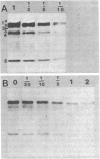Abstract
Pretreatment of serotype Ib group B streptococci with benzylpenicillin, other beta-lactam antibiotics, or vancomycin increased the susceptibility of these bacteria to the bactericidal activity of a mixture of human polymorphonuclear leukocytes and normal human serum. Increased susceptibility of the bacteria to killing by phagocytes was elicited even by exposure to subinhibitory levels of the beta-lactam antibiotics. Inhibitors of protein synthesis did not induce such susceptibility. We investigated the possible biochemical basis of penicillin-induced susceptibility to phagocytosis. Penicillin treatment induced the release of substantial quantities of group B streptococcal surface components into the growth medium (lipoteichoic acid, lipid, and capsular polysaccharide). Labeling of the live streptococci with 3H-labeled penicillin was used to evaluate the effect of exposure to subinhibitory concentrations of this antibiotic on the penicillin-binding proteins. Our results suggested that beta-lactam antibiotics and components of the immune system may act in concert to eliminate invading bacteria.
Full text
PDF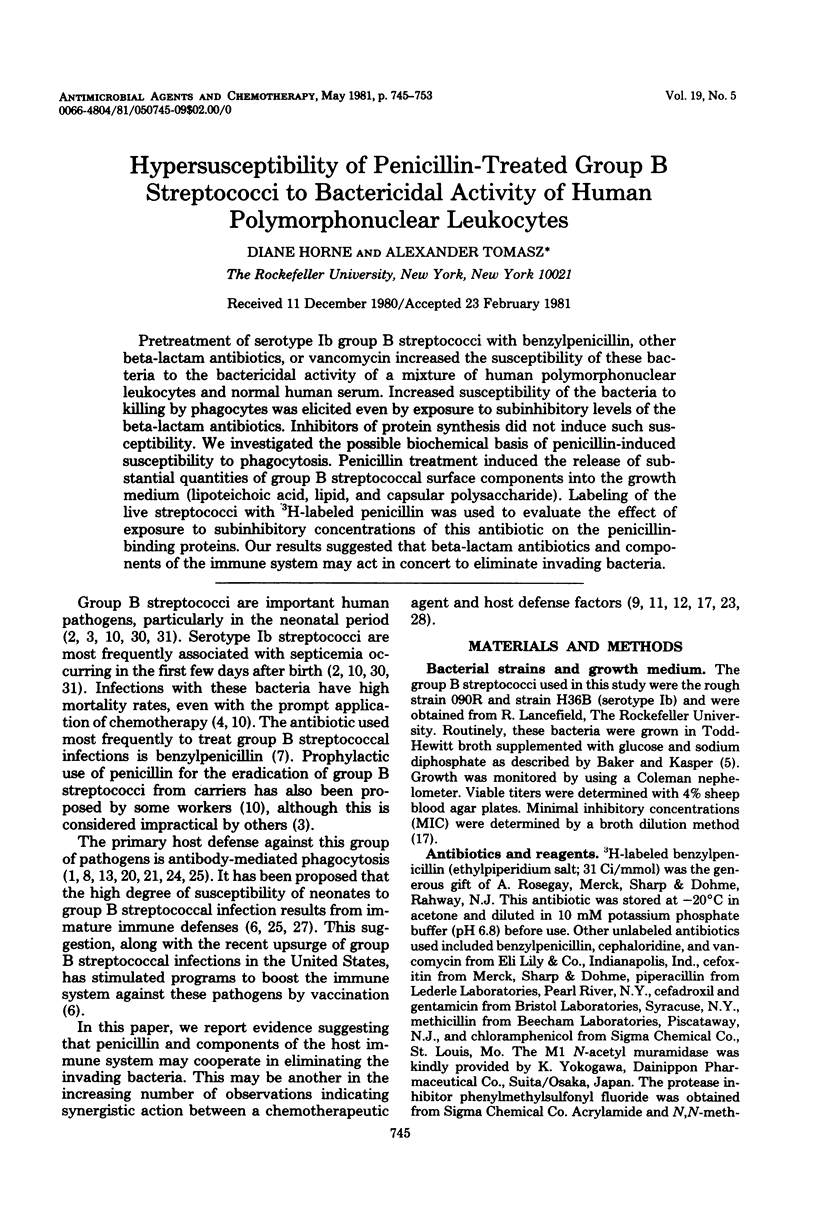
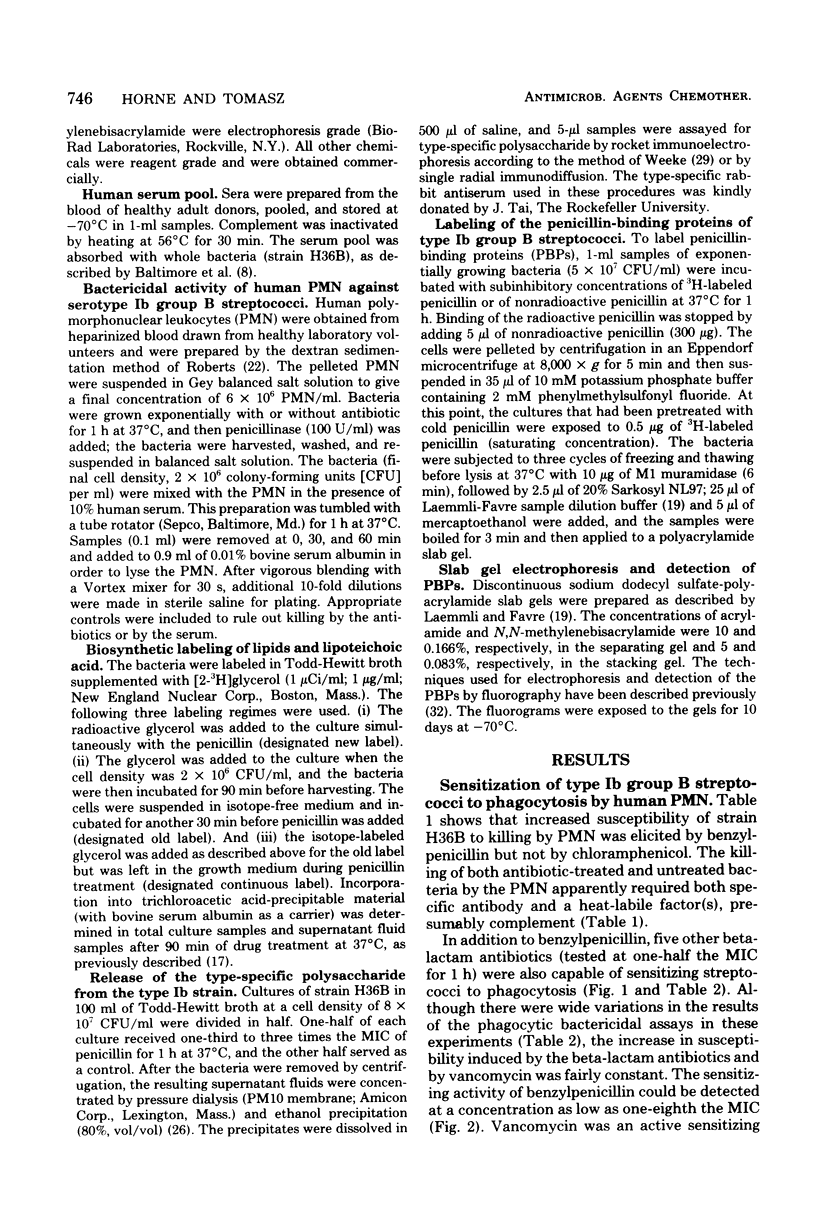
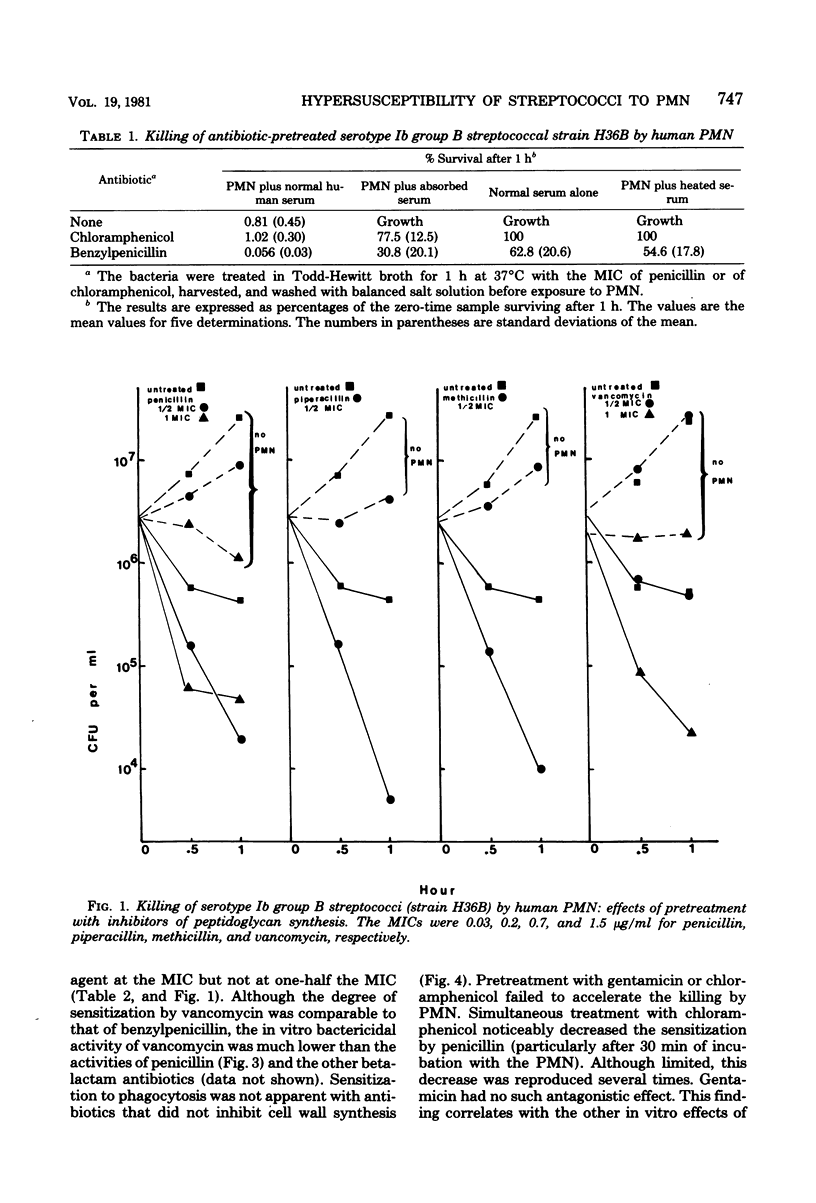
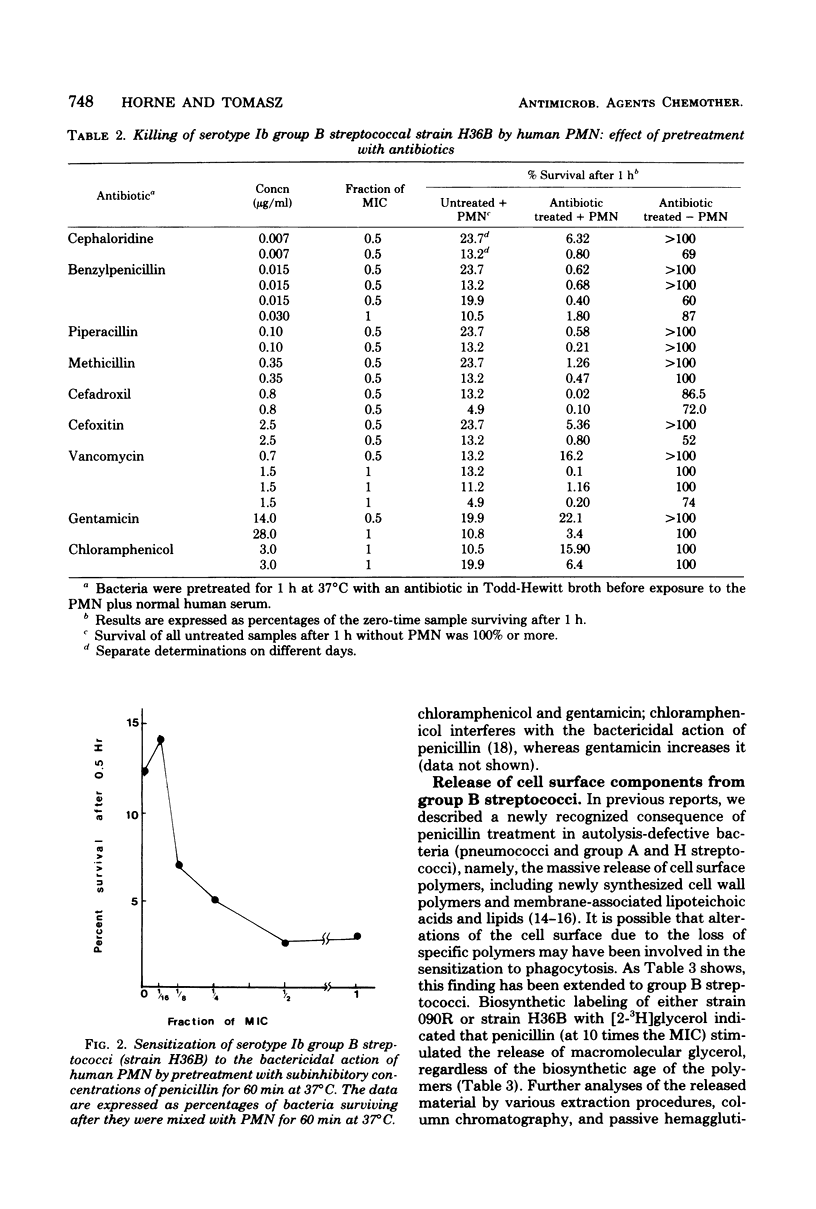
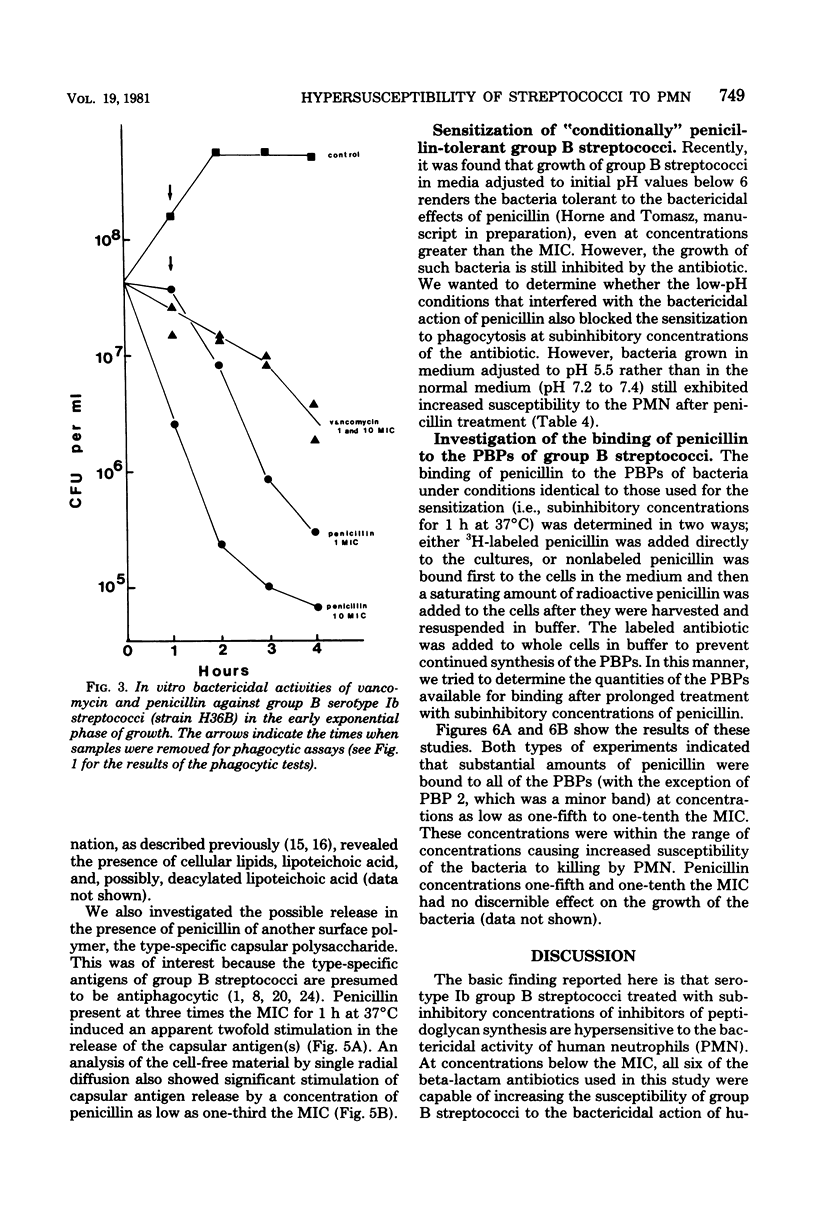
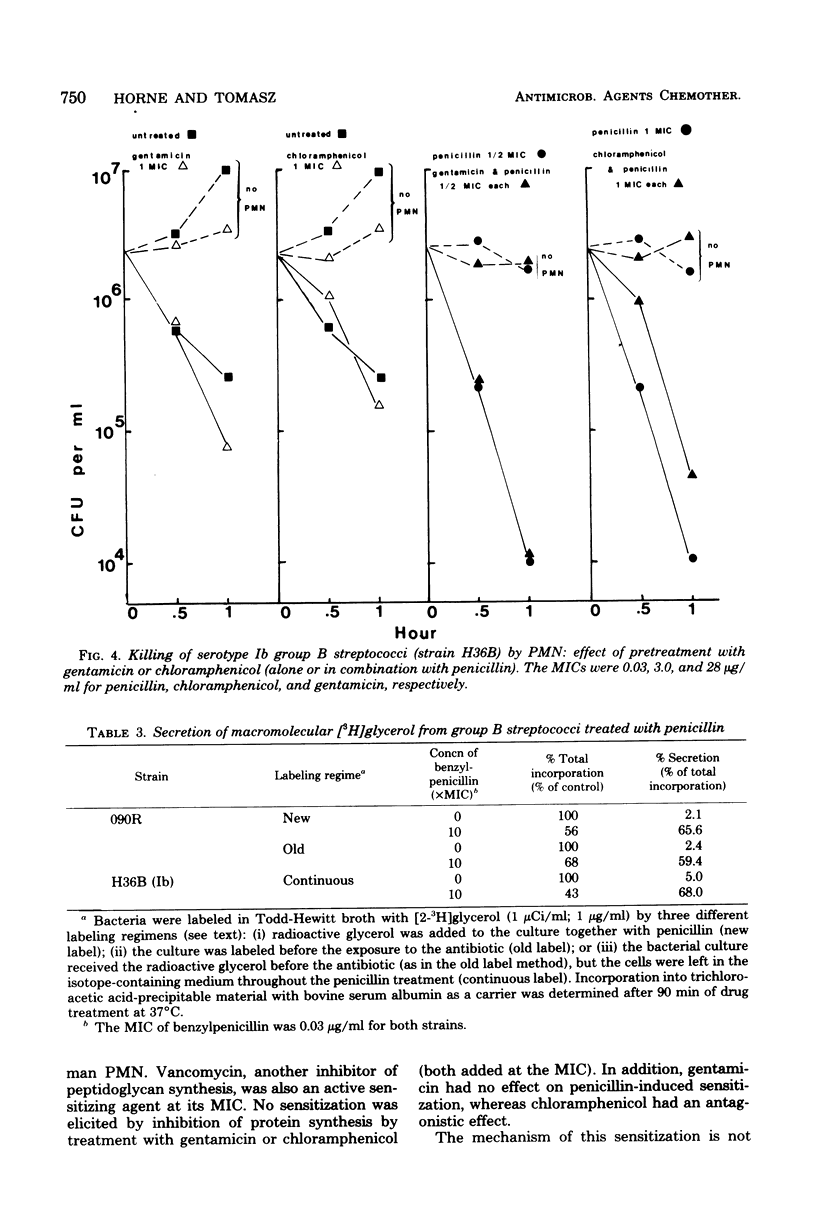
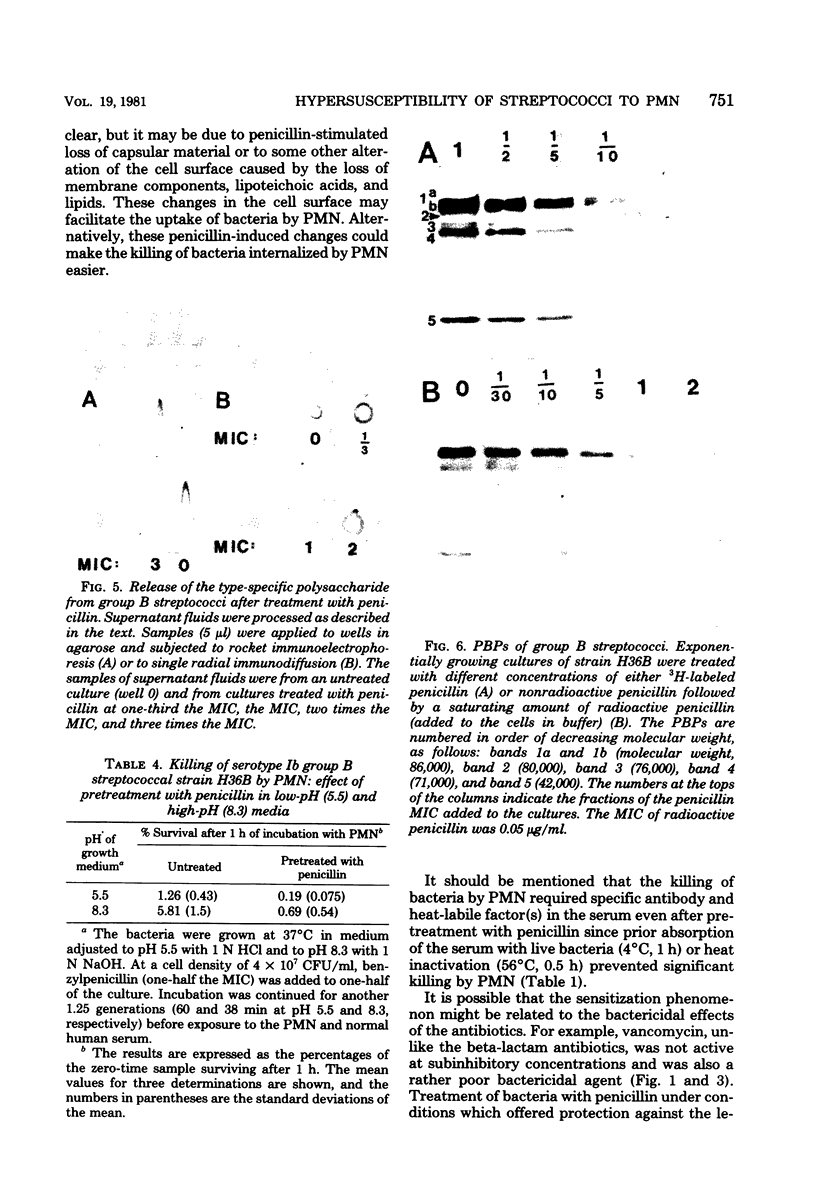

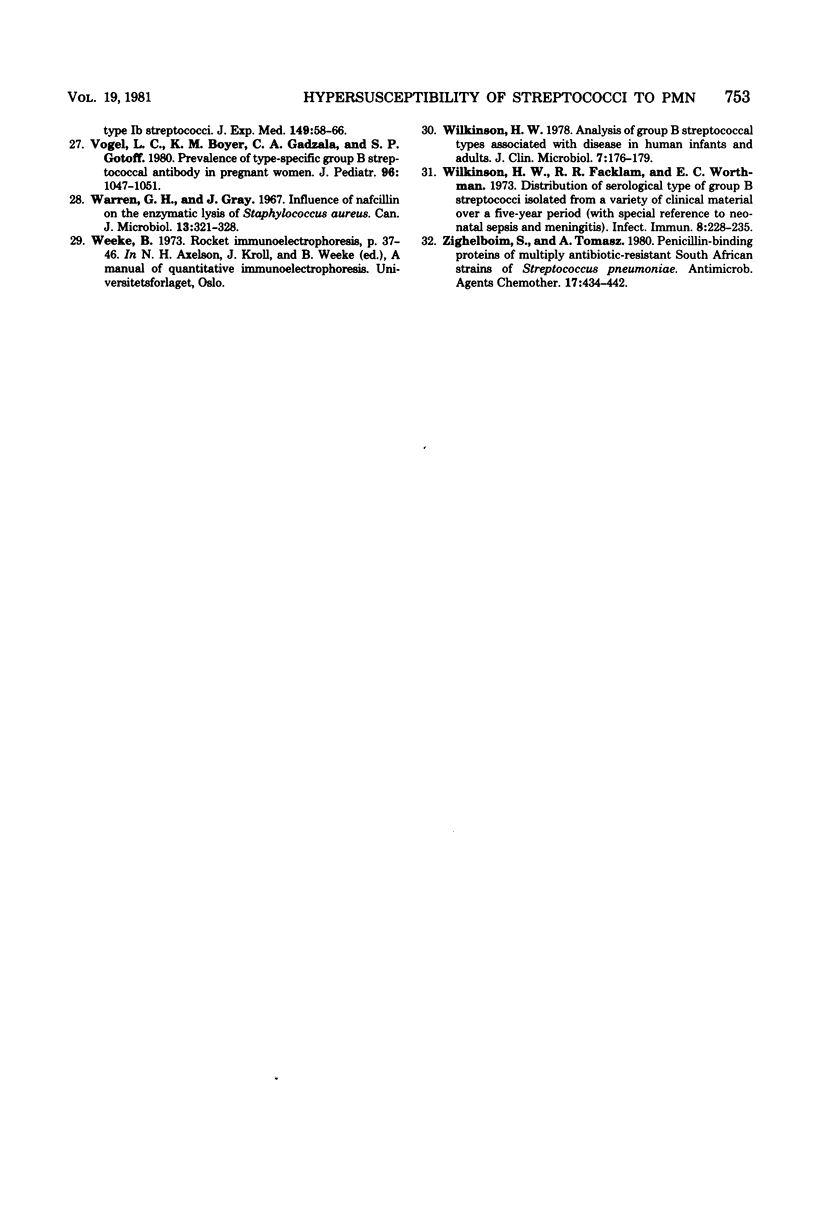
Images in this article
Selected References
These references are in PubMed. This may not be the complete list of references from this article.
- Anthony B. F., Concepcion N. F. Group B streptococcus in a general hospital. J Infect Dis. 1975 Nov;132(5):561–567. doi: 10.1093/infdis/132.5.561. [DOI] [PubMed] [Google Scholar]
- Anthony B. F. Immunity to the group B streptococci: interaction of serum and macrophages with types Ia, Ib, and Ic. J Exp Med. 1976 May 1;143(5):1186–1198. doi: 10.1084/jem.143.5.1186. [DOI] [PMC free article] [PubMed] [Google Scholar]
- Baker C. J., Barrett F. F., Gordon R. C., Yow M. D. Suppurative meningitis due to streptococci of Lancefield group B: a study of 33 infants. J Pediatr. 1973 Apr;82(4):724–729. doi: 10.1016/s0022-3476(73)80606-7. [DOI] [PubMed] [Google Scholar]
- Baker C. J., Barrett F. F. Transmission of group B streptococci among parturient women and their neonates. J Pediatr. 1973 Dec;83(6):919–925. doi: 10.1016/s0022-3476(73)80524-4. [DOI] [PubMed] [Google Scholar]
- Baker C. J., Kasper D. L. Correlation of maternal antibody deficiency with susceptibility to neonatal group B streptococcal infection. N Engl J Med. 1976 Apr 1;294(14):753–756. doi: 10.1056/NEJM197604012941404. [DOI] [PubMed] [Google Scholar]
- Baker C. J., Kasper D. L. Microcapsule of type III strains of group B Streptococcus: production and morphology. Infect Immun. 1976 Jan;13(1):189–194. doi: 10.1128/iai.13.1.189-194.1976. [DOI] [PMC free article] [PubMed] [Google Scholar]
- Baker C. J., Webb B. J., Barrett F. F. Antimicrobial susceptibility of group B streptococci isolated from a variety of clinical sources. Antimicrob Agents Chemother. 1976 Jul;10(1):128–131. doi: 10.1128/aac.10.1.128. [DOI] [PMC free article] [PubMed] [Google Scholar]
- Baltimore R. S., Kasper D. L., Baker C. J., Goroff D. K. Antigenic specificity of opsonophagocytic antibodies in rabbit anti-sera to group B streptococci. J Immunol. 1977 Feb;118(2):673–678. [PubMed] [Google Scholar]
- Franciosi R. A., Knostman J. D., Zimmerman R. A. Group B streptococcal neonatal and infant infections. J Pediatr. 1973 Apr;82(4):707–718. doi: 10.1016/s0022-3476(73)80604-3. [DOI] [PubMed] [Google Scholar]
- Friedman H., Warren G. H. Antibody-mediated bacteriolysis: enhanced killing of cyclacillin-treated bacteria. Proc Soc Exp Biol Med. 1976 Nov;153(2):301–304. doi: 10.3181/00379727-153-39533. [DOI] [PubMed] [Google Scholar]
- Friedman H., Warren G. H. Enhanced susceptibility of penicillin-resistant staphylococci to phagocytosis after in vitro incubation with low doses of nafcillin. Proc Soc Exp Biol Med. 1974 Jul;146(3):707–711. doi: 10.3181/00379727-146-38177. [DOI] [PubMed] [Google Scholar]
- Hemming V. G., Hall R. T., Rhodes P. G., Shigeoka A. O., Hill H. R. Assessment of group B streptococcal opsonins in human and rabbit serum by neutrophil chemiluminescence. J Clin Invest. 1976 Dec;58(6):1379–1387. doi: 10.1172/JCI108593. [DOI] [PMC free article] [PubMed] [Google Scholar]
- Horne D., Hakenbeck R., Tomasz A. Secretion of lipids induced by inhibition of peptidoglycan synthesis in streptococci. J Bacteriol. 1977 Nov;132(2):704–717. doi: 10.1128/jb.132.2.704-717.1977. [DOI] [PMC free article] [PubMed] [Google Scholar]
- Horne D., Tomasz A. Lethal effect of a heterologous murein hydrolase on penicillin-treated Streptococcus sanguis. Antimicrob Agents Chemother. 1980 Feb;17(2):235–246. doi: 10.1128/aac.17.2.235. [DOI] [PMC free article] [PubMed] [Google Scholar]
- Horne D., Tomasz A. Release of lipoteichoic acid from Streptococcus sanguis: stimulation of release during penicillin treatment. J Bacteriol. 1979 Mar;137(3):1180–1184. doi: 10.1128/jb.137.3.1180-1184.1979. [DOI] [PMC free article] [PubMed] [Google Scholar]
- Horne D., Tomasz A. Tolerant response of Streptococcus sanguis to beta-lactams and other cell wall inhibitors. Antimicrob Agents Chemother. 1977 May;11(5):888–896. doi: 10.1128/aac.11.5.888. [DOI] [PMC free article] [PubMed] [Google Scholar]
- Laemmli U. K., Favre M. Maturation of the head of bacteriophage T4. I. DNA packaging events. J Mol Biol. 1973 Nov 15;80(4):575–599. doi: 10.1016/0022-2836(73)90198-8. [DOI] [PubMed] [Google Scholar]
- Lancefield R. C., McCarty M., Everly W. N. Multiple mouse-protective antibodies directed against group B streptococci. Special reference to antibodies effective against protein antigens. J Exp Med. 1975 Jul 1;142(1):165–179. doi: 10.1084/jem.142.1.165. [DOI] [PMC free article] [PubMed] [Google Scholar]
- Mathews J. H., Klesius P. H., Zimmerman R. A. Opsonin system of the group B streptococcus. Infect Immun. 1974 Dec;10(6):1315–1320. doi: 10.1128/iai.10.6.1315-1320.1974. [DOI] [PMC free article] [PubMed] [Google Scholar]
- Roberts R. B. The relationship between group A and group C meningococcal polysaccharides and serum opsonins in man. J Exp Med. 1970 Mar 1;131(3):499–513. doi: 10.1084/jem.131.3.499. [DOI] [PMC free article] [PubMed] [Google Scholar]
- Root R. K., Isturiz R., Molavi A., Metcalf J. A., Malech H. L. Interactions between antibiotics and human neutrophils in the killing of staphylococci. J Clin Invest. 1981 Jan;67(1):247–259. doi: 10.1172/JCI110020. [DOI] [PMC free article] [PubMed] [Google Scholar]
- Shigeoka A. O., Hall R. T., Hemming V. G., Allred C. D., Hill H. R. Role of antibody and complement in opsonization of group B streptococci. Infect Immun. 1978 Jul;21(1):34–40. doi: 10.1128/iai.21.1.34-40.1978. [DOI] [PMC free article] [PubMed] [Google Scholar]
- Stewardson-Krieger P. B., Albrandt K., Nevin T., Kretschmer R. R., Gotoff S. P. Perinatal immunity to group B beta-hemolytic streptococcus type Ia. J Infect Dis. 1977 Nov;136(5):649–654. doi: 10.1093/infdis/136.5.649. [DOI] [PubMed] [Google Scholar]
- Tai J. Y., Gotschlich E. C., Lancefield R. C. Isolation of type-specific polysaccharide antigen from group B type Ib streptococci. J Exp Med. 1979 Jan 1;149(1):58–66. doi: 10.1084/jem.149.1.58. [DOI] [PMC free article] [PubMed] [Google Scholar]
- Vogel L. C., Boyer K. M., Gadzala C. A., Gotoff S. P. Prevalence of type-specific group B streptococcal antibody in pregnant women. J Pediatr. 1980 Jun;96(6):1047–1051. doi: 10.1016/s0022-3476(80)80639-1. [DOI] [PubMed] [Google Scholar]
- Wilkinson H. W. Analysis of group B streptococcal types associated with disease in human infants and adults. J Clin Microbiol. 1978 Feb;7(2):176–179. doi: 10.1128/jcm.7.2.176-179.1978. [DOI] [PMC free article] [PubMed] [Google Scholar]
- Wilkinson H. W., Facklam R. R., Wortham E. C. Distribution by serological type of group B streptococci isolated from a variety of clinical material over a five-year period (with special reference to neonatal sepsis and meningitis). Infect Immun. 1973 Aug;8(2):228–235. doi: 10.1128/iai.8.2.228-235.1973. [DOI] [PMC free article] [PubMed] [Google Scholar]
- Zighelboim S., Tomasz A. Penicillin-binding proteins of multiply antibiotic-resistant South African strains of Streptococcus pneumoniae. Antimicrob Agents Chemother. 1980 Mar;17(3):434–442. doi: 10.1128/aac.17.3.434. [DOI] [PMC free article] [PubMed] [Google Scholar]



